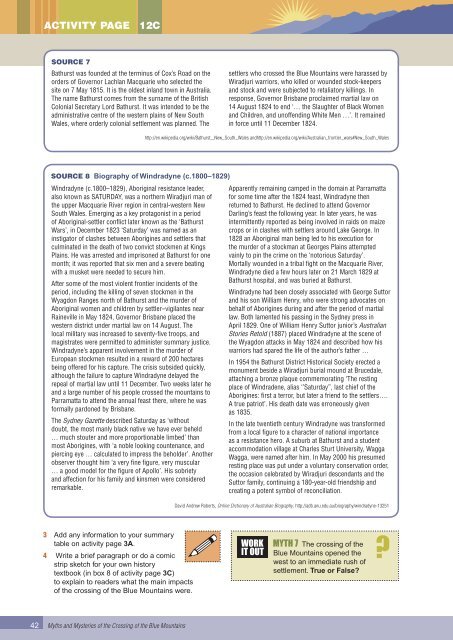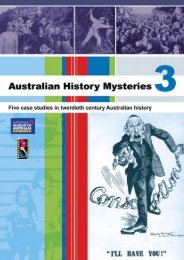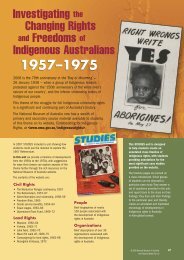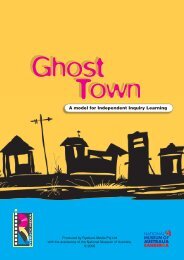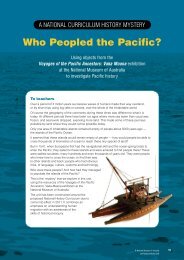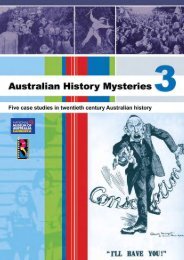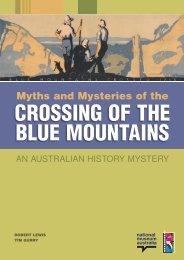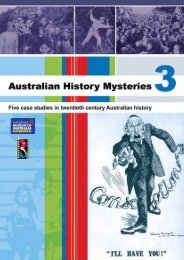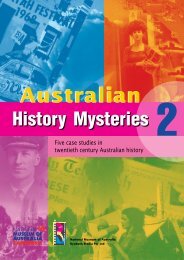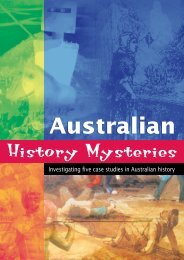Myths and Mysteries of the - Australian History Mysteries
Myths and Mysteries of the - Australian History Mysteries
Myths and Mysteries of the - Australian History Mysteries
You also want an ePaper? Increase the reach of your titles
YUMPU automatically turns print PDFs into web optimized ePapers that Google loves.
Activity page12CSource 7Bathurst was founded at <strong>the</strong> terminus <strong>of</strong> Cox’s Road on <strong>the</strong>orders <strong>of</strong> Governor Lachlan Macquarie who selected <strong>the</strong>site on 7 May 1815. It is <strong>the</strong> oldest inl<strong>and</strong> town in Australia.The name Bathurst comes from <strong>the</strong> surname <strong>of</strong> <strong>the</strong> BritishColonial Secretary Lord Bathurst. It was intended to be <strong>the</strong>administrative centre <strong>of</strong> <strong>the</strong> western plains <strong>of</strong> New SouthWales, where orderly colonial settlement was planned. Thesettlers who crossed <strong>the</strong> Blue Mountains were harassed byWiradjuri warriors, who killed or wounded stock-keepers<strong>and</strong> stock <strong>and</strong> were subjected to retaliatory killings. Inresponse, Governor Brisbane proclaimed martial law on14 August 1824 to end ‘… <strong>the</strong> Slaughter <strong>of</strong> Black Women<strong>and</strong> Children, <strong>and</strong> un<strong>of</strong>fending White Men …’. It remainedin force until 11 December 1824.http://en.wikipedia.org/wiki/Bathurst,_New_South_Wales <strong>and</strong>http://en.wikipedia.org/wiki/<strong>Australian</strong>_frontier_wars#New_South_WalesSource 8 Biography <strong>of</strong> Windradyne (c.1800–1829)Windradyne (c.1800–1829), Aboriginal resistance leader,also known as SATURDAY, was a nor<strong>the</strong>rn Wiradjuri man <strong>of</strong><strong>the</strong> upper Macquarie River region in central-western NewSouth Wales. Emerging as a key protagonist in a period<strong>of</strong> Aboriginal-settler conflict later known as <strong>the</strong> ‘BathurstWars’, in December 1823 ‘Saturday’ was named as aninstigator <strong>of</strong> clashes between Aborigines <strong>and</strong> settlers thatculminated in <strong>the</strong> death <strong>of</strong> two convict stockmen at KingsPlains. He was arrested <strong>and</strong> imprisoned at Bathurst for onemonth; it was reported that six men <strong>and</strong> a severe beatingwith a musket were needed to secure him.After some <strong>of</strong> <strong>the</strong> most violent frontier incidents <strong>of</strong> <strong>the</strong>period, including <strong>the</strong> killing <strong>of</strong> seven stockmen in <strong>the</strong>Wyagdon Ranges north <strong>of</strong> Bathurst <strong>and</strong> <strong>the</strong> murder <strong>of</strong>Aboriginal women <strong>and</strong> children by settler–vigilantes nearRaineville in May 1824, Governor Brisbane placed <strong>the</strong>western district under martial law on 14 August. Thelocal military was increased to seventy-five troops, <strong>and</strong>magistrates were permitted to administer summary justice.Windradyne’s apparent involvement in <strong>the</strong> murder <strong>of</strong>European stockmen resulted in a reward <strong>of</strong> 200 hectaresbeing <strong>of</strong>fered for his capture. The crisis subsided quickly,although <strong>the</strong> failure to capture Windradyne delayed <strong>the</strong>repeal <strong>of</strong> martial law until 11 December. Two weeks later he<strong>and</strong> a large number <strong>of</strong> his people crossed <strong>the</strong> mountains toParramatta to attend <strong>the</strong> annual feast <strong>the</strong>re, where he wasformally pardoned by Brisbane.The Sydney Gazette described Saturday as ‘withoutdoubt, <strong>the</strong> most manly black native we have ever beheld… much stouter <strong>and</strong> more proportionable limbed’ thanmost Aborigines, with ‘a noble looking countenance, <strong>and</strong>piercing eye … calculated to impress <strong>the</strong> beholder’. Ano<strong>the</strong>robserver thought him ‘a very fine figure, very muscular… a good model for <strong>the</strong> figure <strong>of</strong> Apollo’. His sobriety<strong>and</strong> affection for his family <strong>and</strong> kinsmen were consideredremarkable.Apparently remaining camped in <strong>the</strong> domain at Parramattafor some time after <strong>the</strong> 1824 feast, Windradyne <strong>the</strong>nreturned to Bathurst. He declined to attend GovernorDarling’s feast <strong>the</strong> following year. In later years, he wasintermittently reported as being involved in raids on maizecrops or in clashes with settlers around Lake George. In1828 an Aboriginal man being led to his execution for<strong>the</strong> murder <strong>of</strong> a stockman at Georges Plains attemptedvainly to pin <strong>the</strong> crime on <strong>the</strong> ‘notorious Saturday’.Mortally wounded in a tribal fight on <strong>the</strong> Macquarie River,Windradyne died a few hours later on 21 March 1829 atBathurst hospital, <strong>and</strong> was buried at Bathurst.Windradyne had been closely associated with George Suttor<strong>and</strong> his son William Henry, who were strong advocates onbehalf <strong>of</strong> Aborigines during <strong>and</strong> after <strong>the</strong> period <strong>of</strong> martiallaw. Both lamented his passing in <strong>the</strong> Sydney press inApril 1829. One <strong>of</strong> William Henry Suttor junior’s <strong>Australian</strong>Stories Retold (1887) placed Windradyne at <strong>the</strong> scene <strong>of</strong><strong>the</strong> Wyagdon attacks in May 1824 <strong>and</strong> described how hiswarriors had spared <strong>the</strong> life <strong>of</strong> <strong>the</strong> author’s fa<strong>the</strong>r …In 1954 <strong>the</strong> Bathurst District Historical Society erected amonument beside a Wiradjuri burial mound at Brucedale,attaching a bronze plaque commemorating ‘The restingplace <strong>of</strong> Windradene, alias ‘’Saturday”, last chief <strong>of</strong> <strong>the</strong>Aborigines: first a terror, but later a friend to <strong>the</strong> settlers….A true patriot’. His death date was erroneously givenas 1835.In <strong>the</strong> late twentieth century Windradyne was transformedfrom a local figure to a character <strong>of</strong> national importanceas a resistance hero. A suburb at Bathurst <strong>and</strong> a studentaccommodation village at Charles Sturt University, WaggaWagga, were named after him. In May 2000 his presumedresting place was put under a voluntary conservation order,<strong>the</strong> occasion celebrated by Wiradjuri descendants <strong>and</strong> <strong>the</strong>Suttor family, continuing a 180-year-old friendship <strong>and</strong>creating a potent symbol <strong>of</strong> reconciliation.David Andrew Roberts, Online Dictionary <strong>of</strong> <strong>Australian</strong> Biography, http://adb.anu.edu.au/biography/windradyne-132513 Add any information to your summarytable on activity page 3A.4 Write a brief paragraph or do a comicstrip sketch for your own historytextbook (in box 8 <strong>of</strong> activity page 3C)to explain to readers what <strong>the</strong> main impacts<strong>of</strong> <strong>the</strong> crossing <strong>of</strong> <strong>the</strong> Blue Mountains were.The crossing <strong>of</strong> <strong>the</strong>Blue Mountains opened <strong>the</strong>west to an immediate rush <strong>of</strong>settlement. True or False?42<strong>Myths</strong> <strong>and</strong> <strong>Mysteries</strong> <strong>of</strong> <strong>the</strong> Crossing <strong>of</strong> <strong>the</strong> Blue Mountains


